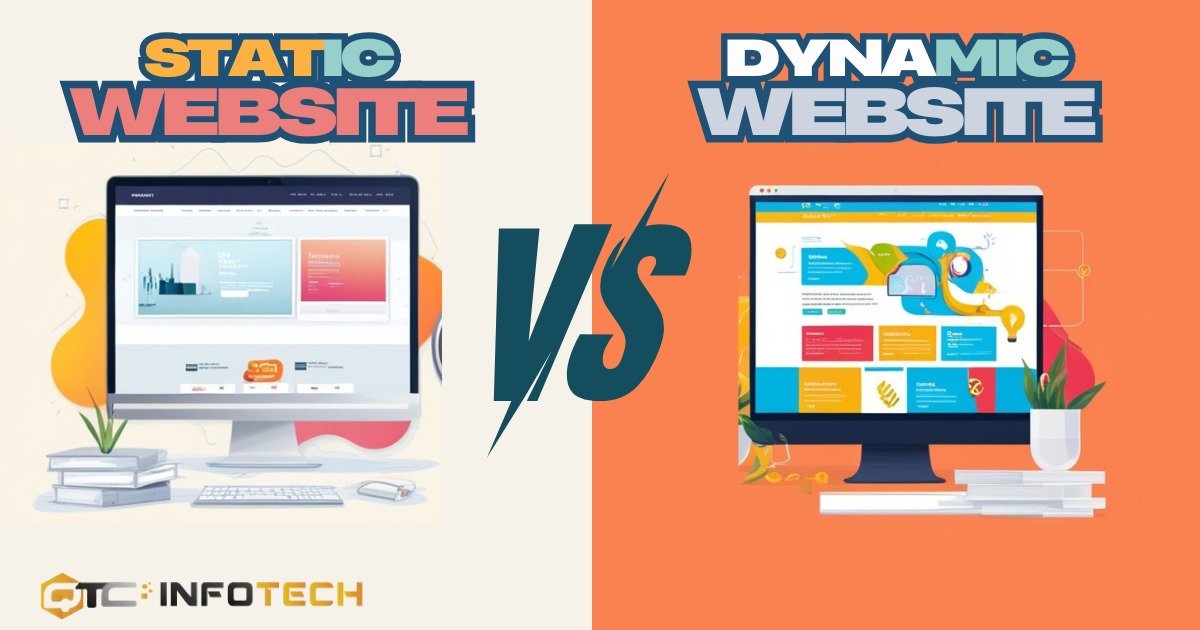In today’s digital world, having a well-designed website is crucial for business success. Whether you run a startup or a large enterprise, selecting the right type of website impacts user experience, performance, and scalability. A web development agency for startups or an affordable web development company often helps businesses decide between static and dynamic websites based on their needs. This blog explores the pros, cons, and differences between the two to help you make an informed decision.
What is a Static Website?
A static website consists of pre-built web pages with fixed content. Any modifications require manual coding, as static sites do not depend on databases or server-side scripting. These websites are built using HTML, CSS, and JavaScript, ensuring fast performance and minimal maintenance. Many website development companies recommend static sites for businesses that require a simple online presence without frequent updates.
Key Features of Static Websites:
- Content updates require manual editing.
- Each page is a separate HTML file stored on a server.
- Uses client-side technologies like HTML, CSS, and JavaScript.
- Does not require a backend database or server-side scripting.
- Fast-loading due to a lightweight structure.
Common Uses of Static Websites:
- Personal portfolios
- Small business websites
- Landing pages and promotional sites
- Simple brochure-style websites
- Basic informational pages
Many website design companies offer website design and development services focused on static websites for businesses seeking cost-effective and easy-to-maintain web solutions.
What is a Dynamic Website?
A dynamic website generates content automatically based on user interactions, database queries, and real-time data processing. Unlike static sites, dynamic websites rely on server-side programming languages such as PHP, Python, Ruby, and Node.js to manage content and user engagement. Many top eCommerce development companies recommend dynamic websites for businesses that need interactive features.
Key Features of Dynamic Websites:
- Content updates occur automatically or through a Content Management System (CMS).
- Uses backend technologies such as PHP, Python, JavaScript frameworks (Node.js), and databases.
- Requires a database to store and retrieve information.
- Supports interactive features, including user logins, comments, and personalized content delivery.
- More complex but highly flexible and scalable.
Common Uses of Dynamic Websites:
- Social media platforms
- E-commerce websites
- CMS platforms like WordPress
- Online forums and communities
- Banking and financial portals
A B2B eCommerce development agency or a web development company often recommends dynamic websites for businesses that require frequent updates, automation, and scalability.
Pros and Cons of Static Websites
Advantages of Static Websites:
✅ Fast Loading Speed – Loads quickly since there is no server-side processing or database queries.
✅ Low Maintenance – No backend infrastructure required, reducing complexity.
✅ High Security – Less vulnerable to cyber threats due to the absence of databases or dynamic scripts.
✅ Cost-Effective – Affordable website development company solutions with lower hosting and development costs.
✅ Simplicity – Easy to design and manage with basic web development skills.
Disadvantages of Static Websites:
❌ Difficult to Update – Requires manual coding for any content changes.
❌ Limited Functionality – Lacks advanced features like user logins, real-time updates, and automation.
❌ Not Scalable – Inefficient for websites requiring frequent content updates or user interactions.
Pros and Cons of Dynamic Websites
Advantages of Dynamic Websites:
✅ Easy to Update – Content can be managed via a CMS without coding.
✅ Enhanced User Interaction – Supports features like user accounts, personalized content, and e-commerce.
✅ Highly Scalable – Ideal for growing businesses that need continuous updates.
✅ Automation Capabilities – Can dynamically generate and modify content in real-time.
✅ Integration with Third-Party Services – Supports APIs, payment gateways, and cloud services.
Disadvantages of Dynamic Websites:
❌ Higher Development Cost – Requires skilled developers for backend programming and database management.
❌ Slower Performance – Server-side processing can lead to longer loading times.
❌ Security Risks – Vulnerable to threats like SQL injection and hacking attempts.
❌ Higher Hosting Costs – Requires robust hosting solutions, increasing operational expenses.
Key Differences Between Static and Dynamic Websites
| Factor | Static Website | Dynamic Website |
| Content Management | Requires manual updates | Uses CMS or automated content generation |
| Performance & Speed | Loads faster | Slightly slower due to database processing |
| Development Complexity | Simple, uses HTML, CSS, and JavaScript | Requires server-side programming and databases |
| Scalability | Limited for frequent updates | Easily scalable with automated content |
| Cost & Maintenance | Lower development & hosting costs | Higher due to database & backend requirements |
Many website development companies offer custom web design and eCommerce development solutions based on these factors to meet different business needs.
When to Choose a Static Website
A static website is ideal if:
- You need a fast-loading and budget-friendly website.
- Security is a top priority due to minimal exposure to cyber threats.
- You need a simple portfolio, business site, or landing page.
- Minimal technical expertise is required for website maintenance.
When to Choose a Dynamic Website
A dynamic website is the best choice if:
- Your site requires frequent content updates and user interaction.
- You need advanced features like eCommerce, user accounts, and personalized content delivery.
- Your business requires scalability and flexibility for future growth.
- You need automated processes and integrations with third-party platforms.
QTC Infotech, a leading web development agency, provides tailored website design and development services to help businesses choose the right web solutions based on these factors.
Conclusion
Choosing between a static and dynamic website depends on your business needs, budget, and long-term goals. Static websites are ideal for businesses that require speed, security, and cost-effectiveness, while dynamic websites offer scalability, automation, and advanced features.
For businesses looking for expert guidance, partnering with a website development company website like QTC Infotech ensures that your website is optimized for performance, functionality, and long-term success. Whether you need a best custom web design, an affordable web development company, or a web development agency for startups, choosing the right website type is the first step toward building a powerful online presence.
Looking for professional website development? Contact us today to build a website that fits your business needs!













